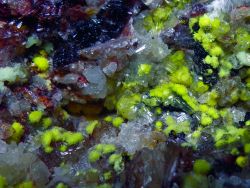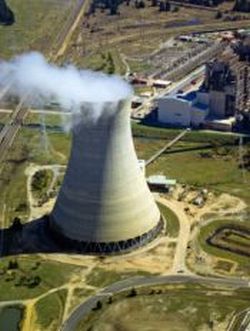Uranium
What is Uranium
Uranium Geology
Uranium Deposits
Uranium Resources
Uranium Mining
Uranium Logs
Uranium

Wyoming is home to the largest known uranium ore reserves in the United States, and has historically ranked No. 1 in uranium production nationally. Wyoming has benefited economically from the uranium industry through jobs, tax revenues, and overall economic growth.

Uranium is a highly valued energy resource found in numerous minerals with major occurrences in Wyoming. Since the 1940s, this heavy metal has been used as a strategic military commodity and for nuclear
power generation. Uranium is an important energy resource because a small quantity can produce a large amount of energy with relatively low carbon dioxide (CO2) emissions. Its radioactive properties were
utilized in making the world’s first nuclear weapons, near the end of World War II. Since then, an entire industry has been built around its mining, processing, and utilization, with Wyoming playing
a significant role in mining uranium ore.
Worldwide, the use of uranium for electrical generation is expected to expand as demand for electricity increases. Because of the demand for this global commodity and its reserves,
Wyoming is likely to benefit from a future increase in the state's production.
Uranium can be found in numerous minerals and occurs nearly everywhere on the planet, even in seawater. Uranium ore deposits occur in many of Wyoming's sedimentary basins, with smaller occurrences found
in other geologic settings throughout the state. Uranium is usually found in porous sedimentary rocks such as sandstones or conglomerates, but some deposits are also associated with igneous and metamorphic rocks.
Uranium Facts
- Symbol — U
- Atomic number — 92 (number of protons in the nucleus)
- Average atomic weight — 238.3 atomic mass units
- Density — 19.05 grams per cubic centimeter (g/cm3), about 238 times the weight of one hydrogen atom and 13 times denser than water
- Group name — Actinide (belonging to the Actinium series)
- Global abundance — (estimated)
- Naturally occurring isotopes —
- 238U atoms make up 99.28 percent of naturally occurring U
- 235U atoms make up 0.72 percent of naturally occurring U
- 234U atoms make up very trace amounts (less than 0.0055 percent) of naturally occurring U
- Common uranium ore minerals —
- Autunite – Ca(UO2)(PO4)2▪10-12(H2O)
- Carnotite – K2(UO2)2(VO)4▪n(H2O)
- Coffinite – USiO4
- Tyuyamunite – Ca(UO2)2(VO4)2▪5-8H2O
- Uraninite – UO2
- Uranophane – Ca(UO2)2Si2O7▪6(H2O)
Recent WSGS Uranium Publications
Uranium Resources 2023 Summary Report, 2024
Uranium Geology and Resources of the Gas Hills District, Wind River Basin, Central Wyoming, 2019
Uranium—Geology and Applications, 2016
Additional WSGS Uranium Publications
Available in the Uranium Section of the WSGS Product Catalog.